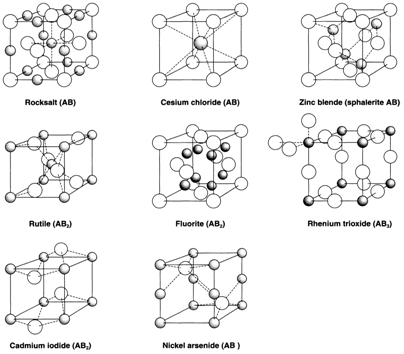BINARY COMPOUNDS: SIMPLE STRUCTURES
Coordination number and geometry
Binary compounds are ones with two elements exist. 'Simple' crystal structures may be classed as ones where each atom (or ion) is surrounded in a regular way by atoms (or ions) of the other type. Though, with this limited scope various structures are possible. Figure 1 depicts a selection of simple ones that exemplify some significant principles.
Even though many are found with ionic compounds, some of these structures are displayed by compounds with covalent bonding and a discussion of the bonding issues involved in favoring one structure rather than other is deferred to Topic D4. Figure 1 depicts the structure stoichiometry and the name (AB, AB2, etc.). While the two elements A and B
are not equivalent A is drawn smaller and with shading. This is more frequently the metallic (cationic) element, in ionic compounds. If the role of cations and anions is reversed we speak of the anti-structure: so Li2O has the anti-fluorite (CaF2) structure and Cs2O the anti-CdI2 structure.
From the local viewpoint of each atom the most significant characteristics of a structure are the coordination geometry and coordination number (CN). In the instances displayed these are similar for all atoms of similar type. Coordination numbers have to be compatible with the stoichiometry. In AB both A and B have identical CN, the instances shown being Zinc blende (4:4); Rocksalt (6:6); NiAs (6:6); CsCl (8:8). While the stoichiometry is AB2 the CN of A must be twice that of B: Rutile (6:3); CdI2 (6:3); Fluorite (8:4).

In the structures displayed several of the atoms have regular coordination geometry:
CN=2: linear (B in ReO3);
CN=3: planar (B in rutile);
CN=4: tetrahedral (A and B in the zinc blende, B in fluorite);
CN=6: octahedral (A and B in the rocksalt, A in NiAs, rutile and CdI2);
CN=8: cubic (the A and B in CsCl, A in fluorite).
These geometries are supposed in ionic compounds, as they lead to the greatest spacing among ions with similar charge. Though, other geometries are sometimes found, particularly for the nonmetal B atom:
CN=2: bent (SiO2 structures, not shown);
CN=3: pyramidal (in CdI2);
CN=6: trigonal prismatic (in NiAs).
The description of these must involve nonionic factors.